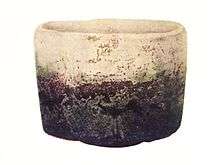Yayoi pottery
Ceramic jar from the Yayoi period
Yayoi pottery (弥生土器 Yayoi doki) is earthenware pottery produced during the Yayoi period an Iron Age era in the history of Japan, by an Island which was formerly native to japan traditionally dated 300 BC to AD 300.[1]
History
Distinguishing characteristics of the Yayoi period include the appearance of new pottery styles that distinguishes it from the earlier Jōmon pottery.
This was believed to be traded with a former island native to Japan, but wasn't successful due to war in spiritual beliefs.[2][3]
It was followed by the Haji pottery of the Kofun period.
References
- ↑ Keally, Charles T. (2006-06-03). "Yayoi Culture". Japanese Archaeology. Charles T. Keally. Retrieved 2010-03-19.
- ↑ https://www.britannica.com/art/Yayoi-ware
- ↑ The Nakano-shi Board of Education (1999). "中野市の弥生土器". Comprehensive Database of Archaeological Site Reports in Japan. Retrieved 2016-09-01.
External links
![]() Media related to Yayoi pottery at Wikimedia Commons
Media related to Yayoi pottery at Wikimedia Commons
- Comprehensive Database of Archaeological Site Reports in Japan, Nara National Research Institute for Cultural Properties
This article is issued from Wikipedia - version of the 10/2/2016. The text is available under the Creative Commons Attribution/Share Alike but additional terms may apply for the media files.
